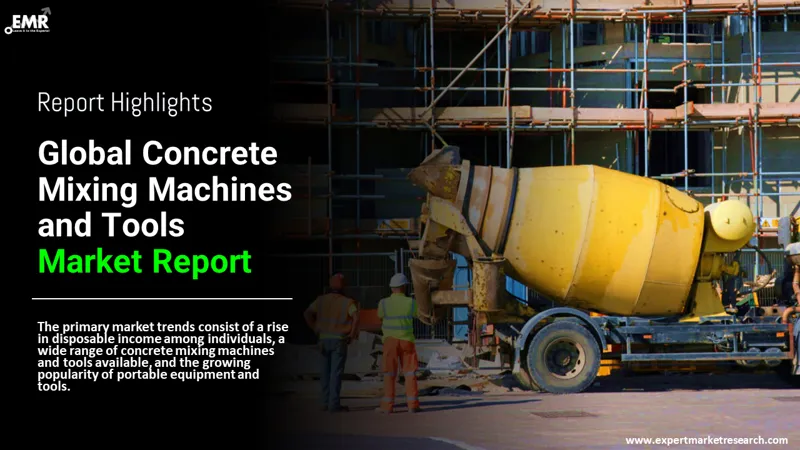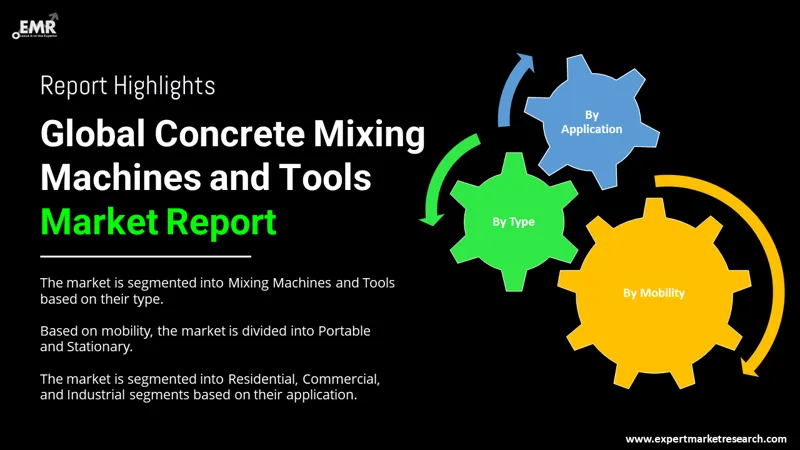
Consumer Insights
Uncover trends and behaviors shaping consumer choices today
Procurement Insights
Optimize your sourcing strategy with key market data
Industry Stats
Stay ahead with the latest trends and market analysis.
The global concrete mixing machines and tools market is expected to grow at a CAGR of 6.80% between 2026 and 2035.
Base Year
Historical Period
Forecast Period
Compound Annual Growth Rate
6.8%
2026-2035
*this image is indicative*
A concrete mixer is a machine that mixes cement, aggregates like gravel or sand, and water to make concrete. Additional tools are used to support the concrete mixing and laying process. A standard concrete mixer employs a spinning drum to blend the elements. It is often utilised directly at construction site so that the concrete can be made as needed. This allows workers ample time to utilise the concrete before it gets hard.
With the launch of handheld portable concrete mixing tools for house repairs, the concrete mixing machines and tools market demand is expected to propel during the forecast period. This is due to the easy storage or cleaning of handheld portable mixing tools and with its help concrete is mixed instantly and without much effort. This lowers the cost of house repairs while maintaining the sturdiness of concrete.

Read more about this report - REQUEST FREE SAMPLE COPY IN PDF
The growing advancements in mixing technologies for concrete production are further expected to drive the market growth of concrete mixing machines and tools across the globe. With the shifting trends in the construction industry, the demand for modern concrete production plants is increasing.
The surging digitalisation of tools is likely to boost market growth through the incorporation of innovative technologies with machines and tools as they are more efficient and reliable. Tracking of tools and performance can be simplified through digitalisation.
Global Concrete Mixing Machines and Tools Market Report and Forecast 2026-2035 offers a detailed analysis of the market based on the following segments:
Market Breakup by Type
Market Breakup by Mobility
Market Breakup by Application
Market Breakup by Region

Read more about this report - REQUEST FREE SAMPLE COPY IN PDF
The comprehensive EMR report provides an in-depth assessment of the market based on the Porter's five forces model along with giving a SWOT analysis. The report gives a detailed analysis of the following key players in the global concrete mixing machines and tools market, covering their competitive landscape and latest developments like mergers, acquisitions, investments and expansion plans.




*While we strive to always give you current and accurate information, the numbers depicted on the website are indicative and may differ from the actual numbers in the main report. At Expert Market Research, we aim to bring you the latest insights and trends in the market. Using our analyses and forecasts, stakeholders can understand the market dynamics, navigate challenges, and capitalize on opportunities to make data-driven strategic decisions.*
Get in touch with us for a customized solution tailored to your unique requirements and save upto 35%!
The market is assessed to grow at a CAGR of 6.80% between 2026 and 2035.
The major market drivers are the growing urban population along with the rising construction industry.
The key market trends include the increasing disposable income among people, variety of concrete mixing machines and tools available, and popularity of portable machines and tools.
Concrete mixers are such devices that are efficient in precisely and quickly mixing combinations of materials to produce concrete of varying strength.
Concrete mix design is known as a procedure of discovering the right ratios of sand, aggregates, and cement, for concrete to attain target strength in structures.
To mix the concrete manually, the use of a shovel or any small tool is preferred, or an individual can use their hands as well for mixing smaller quantities.
Explore our key highlights of the report and gain a concise overview of key findings, trends, and actionable insights that will empower your strategic decisions.
| REPORT FEATURES | DETAILS |
| Base Year | 2025 |
| Historical Period | 2019-2025 |
| Forecast Period | 2026-2035 |
| Scope of the Report |
Historical and Forecast Trends, Industry Drivers and Constraints, Historical and Forecast Market Analysis by Segment:
|
| Breakup by Type |
|
| Breakup by Mobility |
|
| Breakup by Application |
|
| Breakup by Region |
|
| Market Dynamics |
|
| Competitive Landscape |
|
| Companies Covered |
|
Datasheet
One User
USD 2,499
USD 2,249
tax inclusive*
Single User License
One User
USD 3,999
USD 3,599
tax inclusive*
Five User License
Five User
USD 4,999
USD 4,249
tax inclusive*
Corporate License
Unlimited Users
USD 5,999
USD 5,099
tax inclusive*
*Please note that the prices mentioned below are starting prices for each bundle type. Kindly contact our team for further details.*
Flash Bundle
Small Business Bundle
Growth Bundle
Enterprise Bundle
*Please note that the prices mentioned below are starting prices for each bundle type. Kindly contact our team for further details.*
Flash Bundle
Number of Reports: 3
20%
tax inclusive*
Small Business Bundle
Number of Reports: 5
25%
tax inclusive*
Growth Bundle
Number of Reports: 8
30%
tax inclusive*
Enterprise Bundle
Number of Reports: 10
35%
tax inclusive*
How To Order

Select License Type
Choose the right license for your needs and access rights.

Click on ‘Buy Now’
Add the report to your cart with one click and proceed to register.

Select Mode of Payment
Choose a payment option for a secure checkout. You will be redirected accordingly.
Gain insights to stay ahead and seize opportunities.

Get insights & trends for a competitive edge.

Track prices with detailed trend reports.

Analyse trade data for supply chain insights.

Leverage cost reports for smart savings

Enhance supply chain with partnerships.

Connect For More Information
Our expert team of analysts will offer full support and resolve any queries regarding the report, before and after the purchase.
Our expert team of analysts will offer full support and resolve any queries regarding the report, before and after the purchase.
We employ meticulous research methods, blending advanced analytics and expert insights to deliver accurate, actionable industry intelligence, staying ahead of competitors.
Our skilled analysts offer unparalleled competitive advantage with detailed insights on current and emerging markets, ensuring your strategic edge.
We offer an in-depth yet simplified presentation of industry insights and analysis to meet your specific requirements effectively.
Share